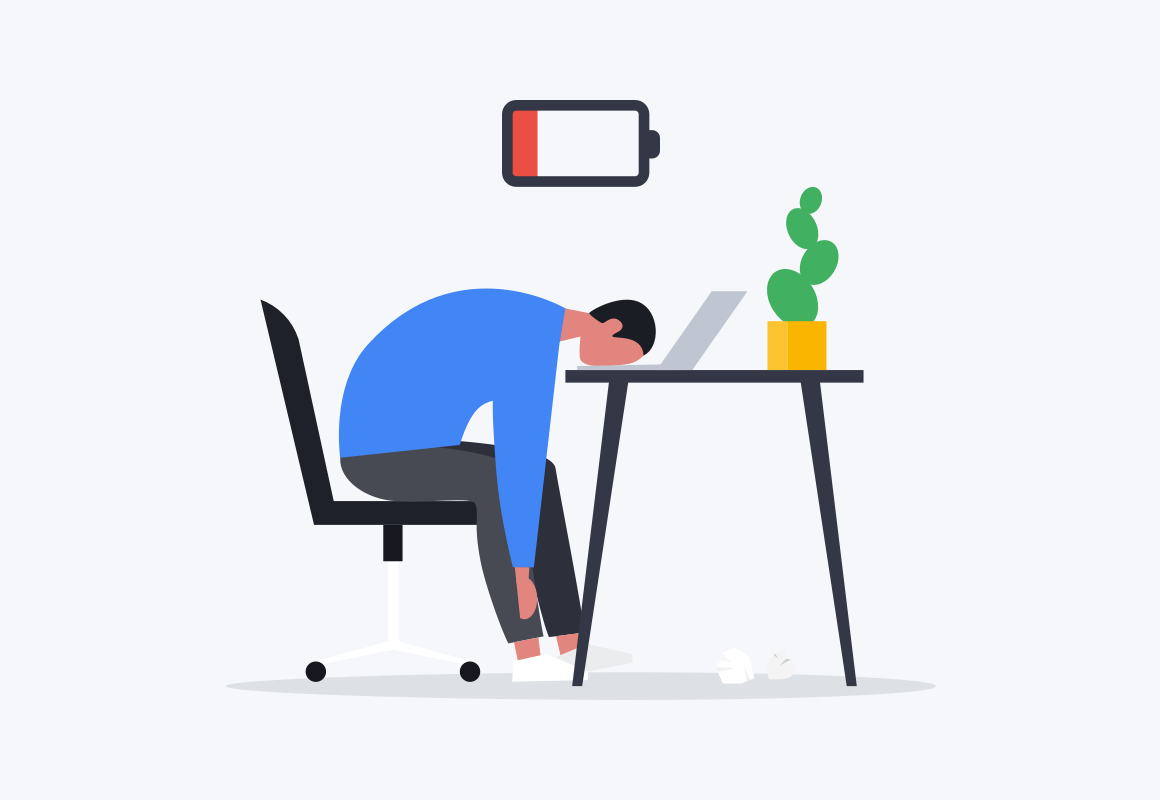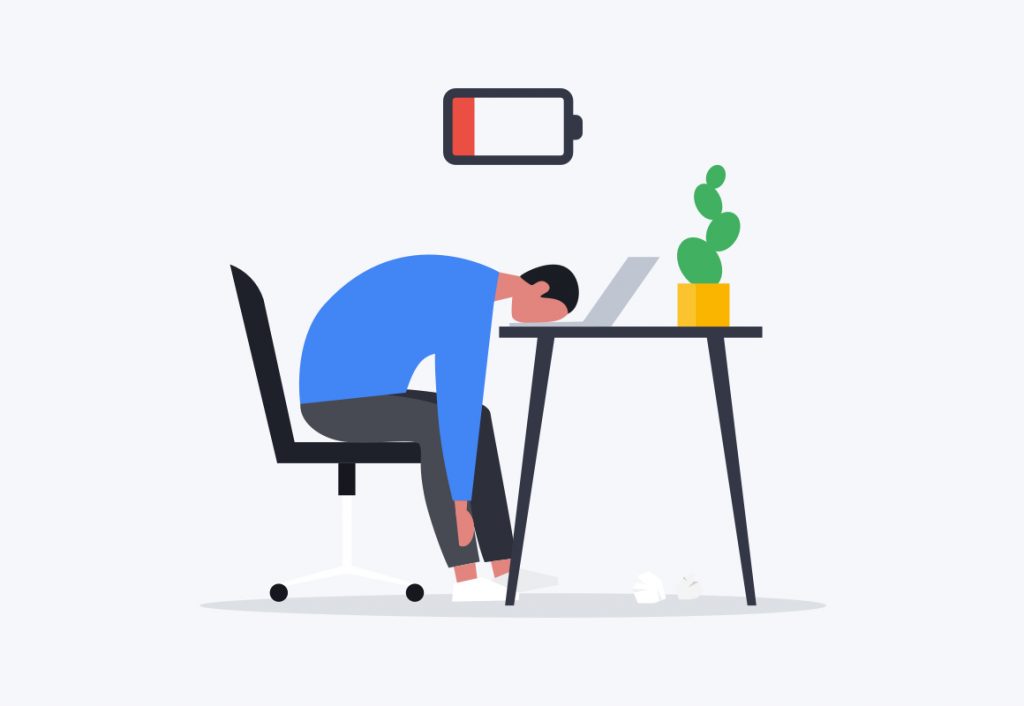“Effective, productive effort, especially in industry, measured by the rate of output per unit of input.”
This is the definition of productivity. But how we judge productivity in our own experience is much more complex, qualitative, and subject to various factors. We know what productivity is supposed to look like because we live in the digital age where an efficient day is publicized on social media for the world to see. The latest productivity tips fill the internet, and top CEOs share their success stories and super-efficiency. But, unfortunately, our vision of productivity has strayed far from reality, and the guilt from a lack of “productivity” fills us with limiting thoughts.
Strict guidelines for a productive workday are rarely communicated, leaving the individual employee to decipher how productive they are. Rather than clear goals, we have open-ended days of collaboration, context switching, and communication. It has become nearly impossible to measure productivity. Ultimately employees understand productivity in terms of their sense of self and personal expectations. Additionally, we often compare ourselves to others who may struggle themselves and portray unrealistic expectations. As a result, our understanding of productivity is very clouded, and we often feel like we are falling behind expectations. How do we know when we have done enough?
What is productivity shame?
Productivity shame is a feeling we get from not doing enough, often because we have no clear standards for enough. It’s the guilt you get for taking a nap, watching too much TV or relaxing, because you could be doing something more productive. Unfortunately, this shame often pulls us into the urgency trap — prioritizing small, time-sensitive tasks for the sake of feeling productive. But, in the long run, we get less done because our focus is derailed by context switching, instant communication, and negative feelings of guilt.
“Shame is the most powerful, master emotion. It’s the fear that we’re not good enough. Because true belonging only happens when we present our authentic, imperfect selves to the world, our sense of belonging can never be greater than our level of self-acceptance.” Leadership Coach, Brene Brown
Often we present our ideal selves to the world, especially in the workplace, and our expectations shoot past reality, only to beat ourselves up because we failed to meet them. This is not to say that you shouldn’t shoot for the stars, but keep in mind what you can realistically accomplish — otherwise, your shame will pull you further away from reaching your goals. For example, picture yourself walking into an interview for your dream job; you’re very likely to present your ideal self: the kind of person you would like to be. The issue? Your ideal self and your actual abilities might not line up, making you feel shameful.
Shame is a powerful and disruptive emotion to our sense of self, confidence, and productivity. According to leadership coach Brene Brown, shame thrives alongside secrecy, silence, and judgment. Projecting your ideal self and ignoring reality fosters shame and keeps you silent and secretive when you feel like you can’t keep up with personal or external expectations. The judgment that accompanies shame can stem from pressure at work or internally because your definition of productivity is warped. When we feel shameful about our productivity, we grasp onto the concept of busyness and do as much as we can in as little time.
Addicted to busywork
Productivity shame has skyrocketed in the shift to remote work, where the lines between work and home are so blurred. Every minute of every day is up for grabs, so we feel like we have to make the most of it by being productive at all times. We’re putting in overtime, skipping lunch, resisting breaks, and powering through for the sake of looking busy. The problem is that busyness does not always equate to productivity, and your output level is not a determinant of good quality work. We feel exhausted from the busy work, but with little or no progress on our big goals, and that’s when we start to feel like we haven’t done enough.
The simple act of slowing down can make us more productive and help align our priorities, but instead, we sink ourselves deeper into busy work. At the heart of productivity shame is the way we understand productivity. Instead of seeing productivity as busyness, we need to quantify productivity as time spent doing the right things. For example, clicking through your inbox is an excellent way to stay busy but puts nothing toward your big goals. The opposite of busyness is not poor time management or low motivation but an actualization of real priorities and purpose. To be creative, productive, and motivated, you need to step back from the modern workplace’s always-on, high-pressure, hectic pace.
Related Post: Overcoming Burnout and the Expectations of the ‘Ideal Worker’

The myth of super-productivity
There is a never-ending stream of productivity-related content: the newest productivity hacks, tips from top CEOs, and Instagram reels on why waking up at 5 am will transform your day. Yes, some of this content might be helpful, but others are counterproductive and untrue. While productivity gurus are waking up at 5 am, going for a morning run, and making an elaborate breakfast all in time to put in 8hours of work, the rest of us are scrambling to reach the next deadline. But what you don’t see are 8 pm bedtimes or the days in which their priorities go amiss.
Often we measure our success in parallel to the most successful people in the world, who we often forget have unproductive days just like the rest of us. Steve jobs only ate two foods a week to stay productive, but that doesn’t mean that you should! Oprah never misses a meeting, but that’s not realistic for most people and will likely lead you to burnout. Simon Freud got his beard trimmed every day, but what if you don’t have a beard! These productivity tips are, quite honestly, ridiculous.
While many people are productive by nailing down daily habits, many people are also unproductive implementing the same habits. Therefore, putting highly successful people on a pedestal can diminish our own efforts and leave us feeling shameful because we don’t achieve the same outcome.
7 ways to break the cycle
Productivity shame ironically inhibits you from completing meaningful work, which is the greatest driver behind employee engagement. Let’s break the cycle of productivity shame and openly discuss what enough should look like for you.
Talk openly about shame
Shame will fester in secrecy, and everyone has felt productivity shame at some point in their careers, meaning you can receive incredibly valuable insights by being open about it. Talking about shame might sound terrifying, but lifting the weight of silence off your shoulders will help you see the big picture more clearly. For example, maybe you need to talk to your boss about more realistic expectations, or perhaps you need to talk to yourself about defining enough. Either way, it is beneficial to get another perspective and open up to a deeper understanding of your shame.
Change the way you think about productivity
As we’ve touched on, many of us see productivity as a state of being busy, but it is quite the opposite. Productivity means you’re working on all the right things at the right time and resisting the urge to context switch and derail focus. A study measuring the productivity of CEOs found they were 500% more productive when engaged in deep work rather than falling into the multitasking trap. The truth is, none of us can effectively multitask, and while you might feel busy, you’re not productive. Deep work might feel a little slower, but you’re working more intentionally. When you get caught up in a “grind mentality,” you lose sight of the big picture and are more likely to reach for the low-hanging fruit rather than meaningful work.
If you start to feel yourself multitasking and are overwhelmed with busyness, ask yourself: is this contributing to the ultimate goal? Or am I working on the right things?
Learn to say ‘no’
Be honest with yourself about what you can realistically accomplish and communicate with others when you feel overwhelmed. If you put on a happy face and continue to take on more than you can handle, you will either feel shameful for not reaching deadlines or work yourself to burn out.
The best way to know when to say yes or no is to track how long it takes to complete specific tasks. So when a new project comes in, you can realistically access the timeframe and know whether or not you have the additional bandwidth. You can track your time using RescueTime or DeskTime.
Limit multitasking
Multitasking is detrimental to your productivity and encourages busyness while prioritizing urgent but unimportant tasks. When you jump around from task to task, you lose your focus, which costs you 40% of your overall productivity. It takes substantially more time to complete a task when you switch contexts and give urgent notifications your attention. Additionally, multitasking causes more errors, expends your energy and, works against your productivity.
To limit multitasking, you need to find a strategy that keeps you focused on top priorities and eliminates disruptions. Think of being productive as a state of flow, and every time you stop what you’re doing to pick up something else, you lose your flow. It takes approximately 23 minutes to refocus your attention on another task after you have switched contexts. For example, when you check your email in the middle of a high-priority task, you will not return to the same level of focus before the interruption. You can curb multitasking by finding a productivity method that works for you. The Eisenhower matrix is a great way to organize your priorities and decipher urgent from important. When you combine the matrix with a strategy for deep work such as Eating The Frog, Time Blocking, or Pomodoro, you are prone to a state of flow.
Related Post: The Price We Pay For Multitasking

Streamline your workflow
With context switching eating up roughly 53% of your day, you need to find a tool that streamlines your workflow and eliminates any extra time spent sorting through tabs, looking for essential documents, or logging into various accounts. Shift is a desktop app that limits daily context switching by aggregating your accounts and streamlining your workflow, equipped with features designed to improve your productivity. A loss of productivity is often the result of a crowded browser that feeds busy work, and Shift is the perfect solution.

Disconnect at the end of the day
When work is so intertwined with home, you must disconnect at the end of the workday to give your brain time to recharge. A study measuring the relationship between job stresses and mentally switching off from work found that off-time is an essential factor in job engagement and employee well-being.
Those that reported actively disconnecting from work at the end of the day experienced:
- Lower work-related stress
- Fewer procrastination habits
- A “state of flow”
- Greater work-life balance
- Healthier relationships at home and work
- Improved mental and physical health
View this post on Instagram
It’s clear that disconnecting from work is beneficial, but sometimes it’s not that easy, so here is a checklist to make sure you’re properly switching off:
Set screen boundaries
Replace your before-bed screen time with a healthier habit, track screen-time to know when you’ve gone too far, or remove tempting devices from your environment.
Tip: A great way to set limits is to ask yourself: Is this bringing me joy? If scrolling through social media for an hour leaves you feeling worse than when you started, maybe it’s time to press delete and find a healthier habit.
Relax (spend time alone to reflect on the day)
It’s critical to distinguish between physical isolation and alone time. You might be physically isolated at work but not giving yourself time to process and regulate emotions. Robbing yourself of this time will reflect in your creativity and productivity at work. The key to alone time is disconnecting from the influences of other minds — whether it be scrolling social media, listening to a podcast, or engaging in a conversation. All of these activities are bound to exhaust you, and you might not even realize it.
Find an activity that completely disconnects you from day-to-day stressors and influences so that you can be alone with your thoughts.
Find a hobby that excites you
Hobbies have been shown to decrease emotional tension, reduce burnout, and relieve stress. Finding a hobby that helps you disconnect from the workday and gets your creative juices flowing will improve your sleep, productivity, and mental health. In addition, finding a hobby leaves you feeling accomplished, productive (without thinking about work) and indirectly improves your work performance.
View this post on Instagram
Control how you disconnect from the workday
Create a shutdown ritual that signals to yourself that it is time to disconnect from work. Control over one aspect of life when most of your days are filled with extracurricular responsibilities or home duties will make you feel liberated and restored. You can recreate every day with a happy ending by controlling your shut-down ritual and preparing yourself for a new day. For example, clean up your workspace, make a list of to-dos for tomorrow, or reflect on the days’ peaks and valleys.
Let go of the shame; it’s not motivating you
Shame isn’t the motivator that many of us think it is. There will always be another email to send, blog to write, or social media to scroll, but you need to determine when you’ve done enough. Break up your goals into manageable chunks so you can track your small wins and see progress towards bigger goals. You will inevitably feel productivity shame if you’re always focused on massive goals because it’s unrealistic to see meaningful progress in a short amount of time. Instead, take advantage of the completion bias — feeling accomplished after hitting the finished button on a task — and check off small tasks that build up to your ultimate goal.
You are likely doing enough; you just haven’t put tracking points in check so you can know that you’re doing enough. The completion bias compounded with the planning fallacy — our tendency to underestimate the amount of time it takes to complete a task — makes us very susceptible to productivity shame. We think a project will take half the time that it really takes and feel shameful when we don’t reach that unrealistic goal. Tracking your progress will give you a baseline for the amount of time each project usually takes, so you don’t fall victim to these fallacies. Feel confident that you are right where you need to be, working on the right things, and let go of the shame that is dragging you down.
Ten articles before and after
How to Manage Multiple Telegram Accounts
Pride Month: Resources to Support the LGBTQIA2S+ Community
CEO Spotlight: Calculating Risk and Unlocking Entrepreneurial Spirit
How to Curb Meeting Fatigue and Hit Refresh
Top 10 Free Tools for Marketers
The Price We Pay For Multitasking
How to Find a Hobby And Boost Your Mood
10 Tips to Organize Your Email Inbox in 2021 (Gmail and Outlook)
